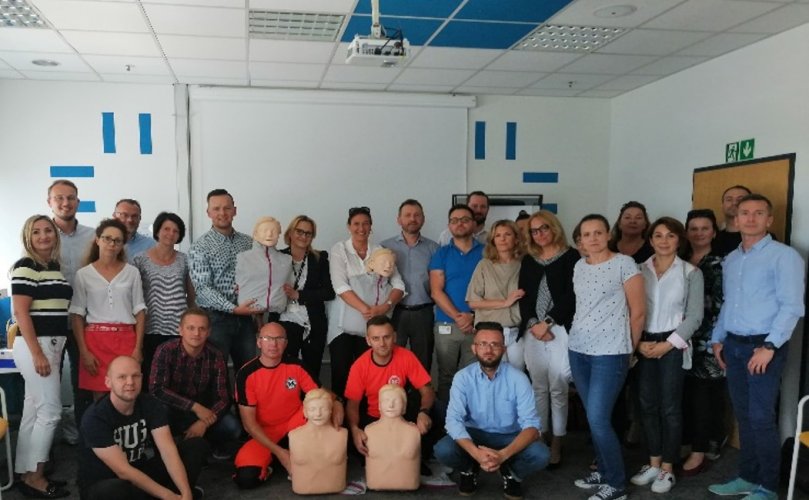
The Importance of Having a First Aid Kit at Work
The first aid kit should provide basic equipment for administering first aid. It should include items to treat cuts, scratches, punctures, grazes, splinters, muscular sprains and strains, minor burns, and major bleeding wounds, broken bones, eye injuries and shock. Extra equipment may be needed in external workplaces, for example for serious burns, breathing difficulties or allergic reactions.
What should I put in the first-aid box?

There is no mandatory list of items to put in a first-aid box. While construction site first aid kits and office first aid kits might differ a little, the basic contents remain the same.

As a guide, where work activities involve low level hazards, a minimum stock of first-aid items would be:
- a leaflet on first aid
- sterile plasters
- sterile eye pads
- triangular sterile bandages
- sterile wound dressings
- gauze roller bandage
- disposable gloves
- adhesive tape
- wound cleaning agent
First aid does not cover the administration of drugs or medications and they should not be kept in the workplace first aid box or kit. In certain circumstances first aiders can assist in the administration of aspirin if available for suspected cardiac chest pain.
Your priorities are to:
- assess the situation – do not put yourself in danger,
- make the area safe,
- assess all casualties and attend first to any unconscious casualties,
- send for help immediately.
Approaching the injured:
- check for a response
- gently shake the person and ask for response
- if there is no response, your priorities are to: shout for help; open the airway; check for normal breathing; take appropriate action.
It is important to recognize the mental consequences of trauma. Offer access to debriefing or counselling to support first aiders and workers after a serious workplace incident.
First aid kits for mobile workers
A portable first aid kit should be provided in the vehicles of mobile workers, for example taxi drivers, sales representatives, bus drivers and inspectors. These kits should be safely located, so as not to become a projectile in a collision.
Maintaining your first aid kit
A person at a workplace should be nominated to maintain the first aid kit. This includes monitoring usage, replacing items used, checking for required items, checking items have not deteriorated, ensuring sterile products remain sealed and are within their expiry dates on a regular basis to make sure the first aid kit is fully stocked when needed.

Other first aid equipment
In addition to first aid kits, it is important to consider if any other first aid equipment is necessary. This should be based on an assessment of the type of work and the likelihood of a serious injury at work. Employees should be involved when deciding whether other first aid equipment are required at your workplace.
For example:
Permanent or portable eyewash and shower equipment
Aim: Providing on-the-spot decontamination and enabling workers to immediately flush away any hazardous substances that may cause an injury.

Emergency showers are designed to flush a person’s head and/or body. In the case of any eye emergency, emergency showers should not be used as the pressure of water flow may damage the eyes.

Invest your time and efforts into prevention
As an employer, you need to inform all your employees of the arrangements that are put in place for first aid. The smartest way is to display notices about:
- contact to first-aiders,
- first-aid box location,
- instruction and training on first aid,
- guide on how to perform CPR,
- how to report injuries and illnesses at the workplace,
- precautions and warnings of hazard: e.g. to avoid exposure to contaminated material,
- emergency exists map.

Warnings and signs are important not only in industrial and commercial workspaces where accidents can occur more frequently and the potential for injury is higher, but in all workplaces. That includes offices, retail stores, and many other places where the risk of danger is less visible. Just because the odds of an accident may be lower in certain work environments doesn’t mean we should take emergency preparedness any less seriously.
Expert tip
from JURENKOVA Gabriela, Product Manager Office Category:
Discover DURAFRAME® SECURITY edition, frames for quick insertion and exchange of safety and warning information via a fold-back magnetic system. This is the ideal solution for safety signs in A4 format on solid surfaces.
When applying at your workplace consider colors:

- green/white: First aid, Escape route maps,
- red/white: Fire safety, danger,
- yellow/black: Occupational safety, Warning or Hazard.
Frame color complies with ISO 3864-4 for safety colors.
Get your own Indexsheet for FIRST AID BOX here
For more information regarding first aid at work contact our specialists.
Continue reading

Safety and well-being as a lever of performance

First aid training may save your life


